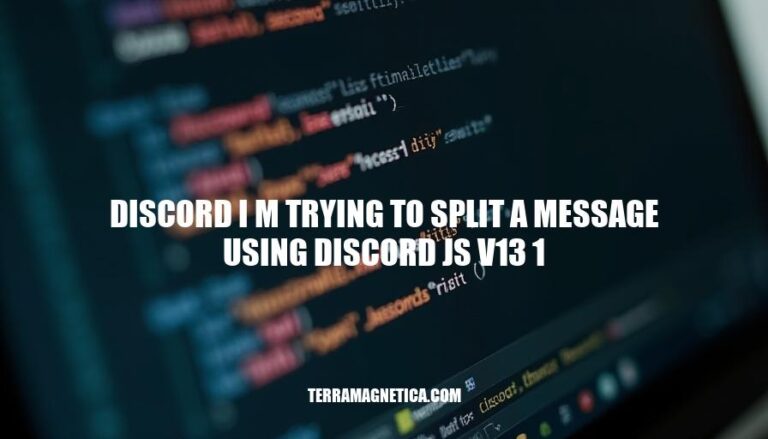


In Discord.js v13, splitting messages is crucial for managing the 2000-character limit imposed by Discord. This feature ensures that lengthy messages are broken down into smaller, manageable parts, enhancing readability and preventing errors. It addresses challenges such as message truncation and the need for manual splitting, making bot development smoother and more efficient.
Discord.js v13 introduced several significant features and improvements:
@discordjs/voice, for better modularity.Regarding your specific query about splitting a message using Discord.js v13, the library’s improvements in message handling and components make it easier to manage and manipulate messages. You can use the split method on a string to divide a message into smaller parts and then send these parts sequentially using the send method of a text channel. This fits well with the enhanced message handling capabilities introduced in v13.
Splitting messages in Discord, especially when using Discord.js v13.1, is essential for several reasons:
2000 Character Limit: Discord imposes a strict limit of 2000 characters per message. If your message exceeds this limit, it must be split into multiple parts to be sent successfully.
Readability: Long messages can be overwhelming and hard to read. Splitting them into smaller, more digestible chunks makes it easier for recipients to follow along and understand the content.
Contextual Clarity: Sometimes, different parts of a message cover distinct topics. Splitting messages helps maintain clarity and ensures that each part is contextually relevant and easier to respond to.
Bot Functionality: When developing bots with Discord.js v13.1, handling large messages efficiently is crucial. Splitting messages allows bots to process and respond to user inputs without hitting character limits or causing errors.
User Experience: For users, receiving multiple smaller messages can be less daunting and more engaging than a single, lengthy block of text.
In practice, you can split messages in Discord.js v13.1 by checking the length of your message and using logic to break it into smaller parts before sending. This ensures compliance with Discord’s character limit and enhances overall communication.
Here are the steps to implement message splitting using discord.js v13:
First, ensure you have discord.js v13 installed. If not, you can install it using npm:
npm install discord.js
Import the necessary modules in your JavaScript file:
const { Client, Intents, Util } = require('discord.js');
const client = new Client({ intents: [Intents.FLAGS.GUILDS, Intents.FLAGS.GUILD_MESSAGES] });
Set up your bot with a basic message event listener:
client.on('messageCreate', message => {
if (message.content.startsWith('!split')) {
const content = message.content.slice(7); // Remove the command part
const splitMessages = Util.splitMessage(content, { maxLength: 2000 });
splitMessages.forEach(part => {
message.channel.send(part);
});
}
});
client.login('YOUR_BOT_TOKEN');
Client, Intents, and Util from discord.js.Client instance with the necessary intents.messageCreate event.!split and slice the command part off.Util.splitMessage to split the message content into chunks of up to 2000 characters.Make sure to replace 'YOUR_BOT_TOKEN' with your actual bot token and run your bot:
node your-bot-file.js
This setup will allow your bot to split long messages into smaller chunks and send them sequentially in the channel.
Here are some common issues and solutions when splitting messages using Discord.js v13:
Message Length Exceeds Limit:
splitMessage to break the message into chunks:const { Util } = require('discord.js');
const messageChunks = Util.splitMessage(longMessage, { maxLength: 2000 });
for (const chunk of messageChunks) {
await channel.send(chunk);
}
Incorrect Splitting:
function splitMessage(str, size) {
const regex = new RegExp(`.{1,${size}}(\\s|$)|\\S+?(\\s|$)`, 'g');
return str.match(regex);
}
const messageChunks = splitMessage(longMessage, 2000);
for (const chunk of messageChunks) {
await channel.send(chunk);
}
Deprecated Methods:
Util.splitMessage might be deprecated.const { splitMessage } = require('@discordjs/builders');
const messageChunks = splitMessage(longMessage, { maxLength: 2000 });
for (const chunk of messageChunks) {
await channel.send(chunk);
}
Node Version Compatibility:
node -v
# If version is below 16.6, update Node.js
Handling Errors:
try {
for (const chunk of messageChunks) {
await channel.send(chunk);
}
} catch (error) {
console.error('Failed to send message chunk:', error);
}
These tips should help you effectively split and send messages using Discord.js v13.
Here are some best practices for splitting messages using Discord.js v13.1:
function splitMessage(str, size) {
const numChunks = Math.ceil(str.length / size);
const chunks = new Array(numChunks);
for (let i = 0, c = 0; i < numChunks; ++i, c += size) {
chunks[i] = str.substr(c, size);
}
return chunks;
}
const messageChunks = splitMessage(longMessage, 2000);
for (const chunk of messageChunks) {
await channel.send(chunk);
}
Asynchronous Handling:
async/await to ensure messages are sent in order and avoid blocking the event loop.async function sendMessageChunks(channel, message) {
const messageChunks = splitMessage(message, 2000);
for (const chunk of messageChunks) {
await channel.send(chunk);
}
}
Error Handling:
async function sendMessageChunks(channel, message) {
try {
const messageChunks = splitMessage(message, 2000);
for (const chunk of messageChunks) {
await channel.send(chunk);
}
} catch (error) {
console.error('Error sending message:', error);
}
}
Rate Limiting:
async function sendMessageChunks(channel, message) {
const messageChunks = splitMessage(message, 2000);
for (const chunk of messageChunks) {
await channel.send(chunk);
await new Promise(resolve => setTimeout(resolve, 1000)); // 1-second delay
}
}
Logging:
async function sendMessageChunks(channel, message) {
const messageChunks = splitMessage(message, 2000);
for (const chunk of messageChunks) {
await channel.send(chunk);
console.log('Message chunk sent:', chunk);
}
}
These practices should help you effectively split and send messages using Discord.js v13.1 while optimizing your code and ensuring smooth delivery. Happy coding!
Mastering the art of splitting messages using Discord.js v13.1 is crucial for efficient and effective Discord bot development.
To achieve this, developers should focus on implementing message chunking, error handling, rate limiting, and logging to ensure smooth delivery and optimal performance.
By following these best practices, developers can write robust and reliable code that meets the demands of modern Discord bots.
Effective message splitting enables developers to send large messages without overwhelming users or triggering rate limits, making it an essential skill for any Discord bot developer.